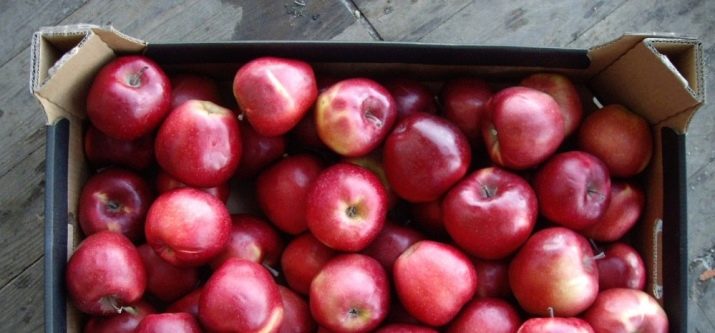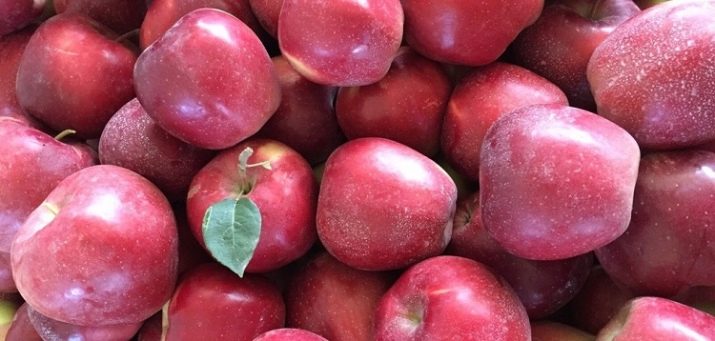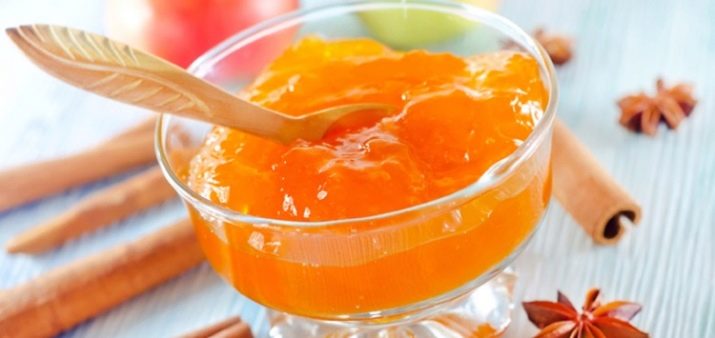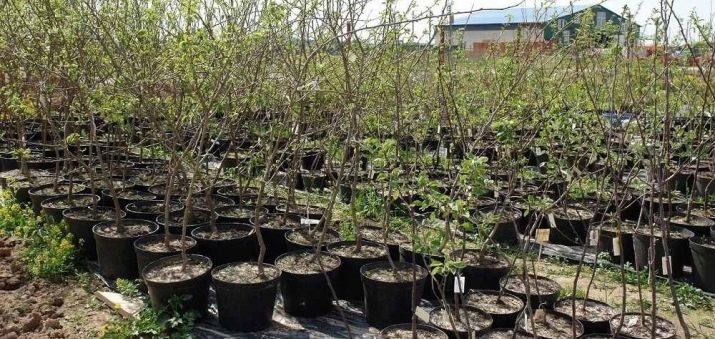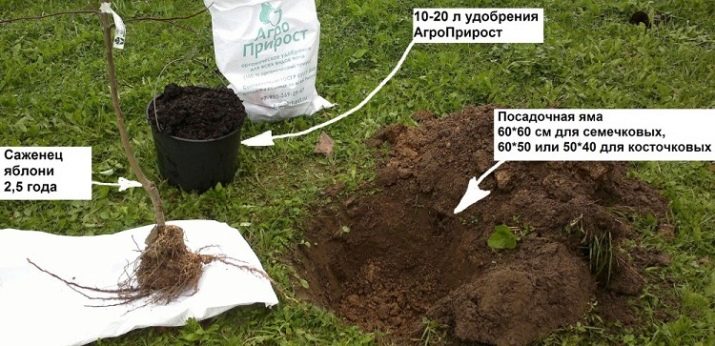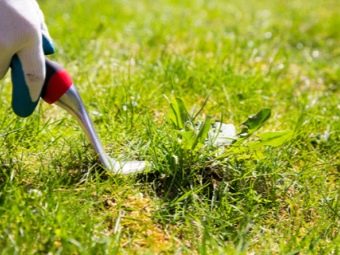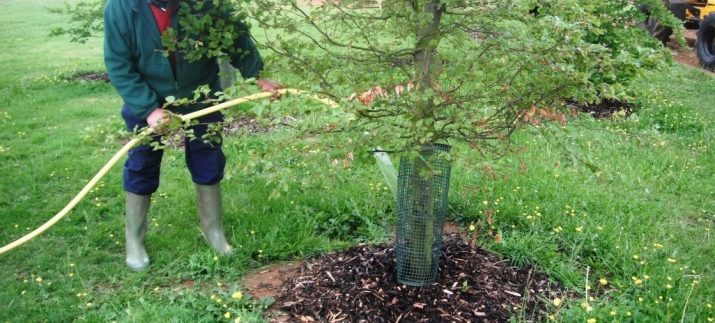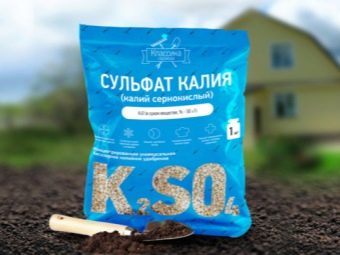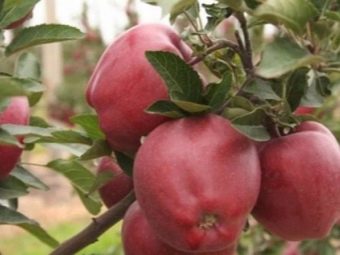Gloucester apple variety: characteristics and cultivation rules
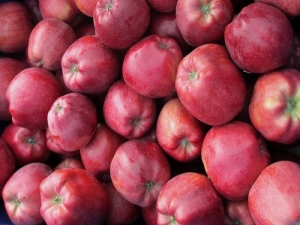
Most owners of cottages and land plots are engaged in growing vegetables and fruits not only for personal use, but also for commercial purposes. In this regard, it is necessary to choose varieties that have excellent taste, presentation, high yield and other necessary parameters. These are the characteristics of the Gloucester apple variety.
Tree description
As the main quality of the variety, experts highlight the rapid development of apple trees. In the early years it is especially noticeable. The crown can be either oval or pyramidal. In the process of tree development, it becomes round. The maximum height can reach up to 2.5 meters, while the diameter of the crown will be about 3 meters. Skeletal branches form sharp corners when moving away from a tree trunk.
The flowering period of apple trees of the above variety falls at the end of spring - the second half of May. Trees bloom for a long time. From 3 to 4 buds are collected in each inflorescence. Approximately 16% of the total crop comes from free pollination of the fruit crop.
To get maximum fruits, gardeners recommend planting pollinators near. The following varieties are used: "James Grieve", "Gala", "Idared", "Spartan" and others. There is no sense in getting rid of the excess ovary, for the reason that one apple is formed in one inflorescence.
Fruit
The shape of the apples is round-conical. Color - saturated red, there are slight blotches of yellow. On the top of the fruit there is a pronounced ribbing. Weight ranges from 140 to 180 grams. The largest fruits can grow up to 200 grams. The protective skin is strong and medium in thickness.
Fruits have a smooth and glossy surface with a characteristic shine. Also, the apples are characterized by a wide calyx with a large depression, as a rule, of a closed type. Seeds in apples a little. Ripe pulp has a light cream color. It is a juicy and tender fruit of sweet-sour taste with a pronounced crunch. The commission of professional tasters rated the gastronomic qualities of the fruit at 4.5 points out of 5 possible. Also remarkable taste noted ordinary consumers.
Fruit benefits
Apples are famous not only for their taste, but also for their great benefit to the body. As part of the fruit contains many microorganisms that are necessary for full development and good health. Main cast:
- vitamins of various groups;
- iron;
- vitamin C;
- cellulose;
- salts;
- antioxidants.
Medical professionals recommend regularly eating Gloucester apples for people who suffer from anemia or chronic fatigue. They will also be useful to those who have suffered heart attacks. Cellulose, which is rich in fruits, will clear the intestines of toxins and other harmful substances in the body. Calorie fruits are low, so they can be eaten by those who are on a diet.
When used reasonably, apples remove excess cholesterol from the blood. Pectin, which is found in large quantities in apples, will help to get rid of it in the liver. Regular consumption of fruit will positively affect the process of digestion and metabolism.
Yield
Gardeners celebrate regular and stable fruiting. This figure with proper care increases from year to year. The tree, which was grafted on the middle-growing stock, pleases with a crop 4 years after landing on the site. In this case, in the third year, the process begins with the appearance of full-fledged apples on dwarf rootstocks. About 75 kilograms of fruit are harvested from trees whose age has reached 10 years.
Pros and cons varieties
There are a lot of advantages at a grade.
- Gastronomic quality at the highest level.
- The beauty and attractiveness of the fruit.
- The fruits are universal. They are ideal for preparations for the winter, as well as a fresh delicacy for every day.
- The benefits of the crop. Vitamin C and other components strengthen the immune system, protect against diseases and viruses.The pressure and the work of the heart are normalized by antioxidants in the composition of apples.
- Trees are able to withstand frosts up to 25 degrees Celsius.
- Apples have high keeping quality and do not deteriorate during long shipments.
- Apples are not afraid of powdery mildew due to innate immunity to this fungal disease. Experts note the average resistance to scab.
disadvantages
As the main minus of the variety, the possibility of frosting of young shoots and buds during early spring frosts is highlighted. Please note that for stomach ulcers, as well as gastritis, eating Gloucester apples is possible only in small quantities. Otherwise, it may lead to a deterioration of health.
Growing region
Apple trees are especially popular in Western Europe. The first attempts at cultivating this variety and growing on an industrial scale were carried out on the territory of Ukraine. These are gardens on the territory of the southern regions of Polesia, forest-steppe and steppe areas. In Russia, Gloucester apple trees are in demand in the southern locations of the state.
Selection of seedlings
Every gardener wants to grow a beautiful, healthy and productive tree. To achieve an optimal result, you need to properly care for the plant and follow certain recommendations in the process of growing. When choosing a young tree, you must remember that Apple trees that are older than 2 years, take root in a new place much worse. On the two-year tree should be placed from 2 to 3 shoots extending from the stamp. Choose a plant with a strong, strong, developed and whole root system. Before buying, carefully inspect it, branches and trunk for damage.
Before planting, it is recommended to carry out a special procedure, which has a positive effect on strengthening the roots. To do this, they must be placed for about 2-3 hours in the composition to stimulate growth. As an additional element in the composition, you can add a fungicide. He will protect the tree from diseases.
Landing site and timing
An ideal place for planting apple trees is a carefully illuminated area, which is also securely sheltered from strong and gusty winds. The above grade is not demanding to the composition of the soil, however, the highest yield is obtained on sandy or loamy soil. When choosing a landing site, discard locations in lowlands where water stagnates. If you intend to plant trees in the fall, it is necessary to carry out work a month before the onset of the first frost. You can also plant apples in the spring, immediately after the ground has warmed up after the winter cold. Kidneys must be closed. A pit is prepared for the landing, about a meter in diameter and 60 centimeters deep. To feed the plant, the first layer of the earth is mixed with organic compounds and mineral-based feedings. Step landing looks like.
- First, you should gently straighten the root system of the tree. Get rid of damaged roots. Sections are treated with a solution of potassium permanganate (0.5%).
- Part of the land is poured into the pit.
- After it is placed in a tree and covered with the remaining soil. At the same time, the root neck of an apple tree should be located at a height of approximately 3 to 5 centimeters from the ground.
- Upon completion of transplanting, it is necessary to pour warm water on the tree and ram the ground a little.
- Next to the plant on the north side is a strong floor. This is a backup for the tree. The plant is tied to him by a figure of eight.
- To maintain optimum moisture, the land is covered with vegetable-type mulch.
Care features
To make the crop pleased with the quantity and quality it is necessary to carry out the following work:
- loosening the soil around the apple tree;
- weed removal;
- regular watering;
- pruning and removal of damaged branches;
- fertilizer;
- Treating trees with chemicals that protect against diseases and pests.
Watering rules
Great importance is the correct irrigation and the calculation of the required volume. Moisture is needed for tasty, juicy and healthy fruits. The irrigation process is carried out at certain stages of tree development:
- the first time the trees are watered when buds begin to blossom;
- the second time moisture is needed 20 days after the end of flowering;
- 2 weeks before picking up the fruits of the apple tree is watered for the third time;
- to make the tree easier to bear the winter frosts, the last time it is watered in October, in dry weather.
On average, one young seedling will require from 2 to 3 buckets of water. When trees reach the age of 3-5 years, the volume of water needed must be increased to 3-8 buckets at a time. Adult apple trees (6-10 years old) need 12-15 buckets per watering. After each procedure, it is strongly recommended to loosen and weed the earth around the tree.
Fertilizer
As soon as a year passed after planting, it was time for the first feeding. The ideal time is spring, the first leaves should appear on the tree. 40 grams of ammonium nitrate and the same amount of nitroammophoska are added to the soil. Organic matter is also added to the ground for digging - humus (5 buckets). Additional nutritious elements to a tree are necessary during flowering, for an ovary of fruits. To prepare an effective fertilizer, it is necessary to dilute the following components in a bucket of water:
- superphosphate - 100 grams;
- potassium sulfate - 70 grams;
- urea - 300 grams.
In the resulting mixture is mixed with 2 buckets of infusion from bird droppings (chicken) and 5 liters of manure. The recommended dose for one tree - 4 buckets. For the third time, fruit trees are sprayed on top dressings. Conduct work in the summer, when the process of formation of the fruit begins. The following composition is used: a gram of sodium humate and 50 grams of nitrophoska per bucket of pure water. It is necessary to spray in dry weather, in the evening or in the morning.
Top dressing is carried out twice a month, in the period from mid-June until the beginning of the first summer month. Also fertilizers are applied to the ground before hibernating the plant. Most often use complex fertilizers.
Wood pruning
The molding of the crown of a young tree is carried out every year with the normal development of an apple tree. In the process, only those branches are left that do not interfere with the growth of shoots and are placed at an acute angle to the trunk. Further, only sanitary pruning is carried out, during which they get rid of broken, diseased and deformed branches. Similarly, the old branches are gradually replaced by young ones.
Preparing for the winter
Despite the resistance to frost, young apples may not survive the cold season without additional protection. For strapping tables use a dense and sturdy material. It will also protect the skin and lower shoots from rodents. Work is carried out until the trees reach the age of 5-6 years. After this period, the crust will become hard and tough. The soil around the tree must be covered with mulch. To do this, use dry grass, straw, fir branches, sawdust or peat.
Collection and storage
The fruits begin to sing during the end of September and early October. Consumption maturity is achieved after the New Year. In order for the taste qualities of apples to open up in full force, the harvest needs a little time to lie down. In the refrigerator, the shelf life of apples can be extended until May.
Reviews
Most gardeners praised this variety, as evidenced by positive reviews. The main positive qualities were marked by high yield and taste of the fruit. Residents of the northern regions have identified frost resistance varieties. In the negative responses, some gardeners indicated late terms of ripening apples.
Due to the presence of sour taste, some summer residents offer lovers of sweet fruit to opt for other varieties.
To learn how to plant an apple tree, see the following video.

